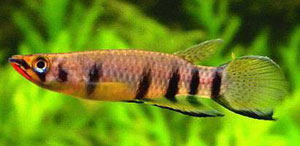It is rather surprising that this fish isn’t much more well-liked in the country, for it is effortlessly fed, very pretty, and provides fairly interesting breeding habits.
The male is the most handsome, with diffused vertical bars along the side of body, and dark edging to the anal fin and base of the caudal fin. The throat and lower lip, greatest seen from the front, are a fiery red. A peculiarity that makes the sexes effortlessly distinguishable is the pointed extension to the caudal fin of the male.
For breeding E. chaperi, a loose-floating plant like Riccia is needed in addition to regular plants. The aquarium should be placed in a position where it’ll not get too a lot sunlight. The very best outcomes are obtained if two females are utilized to one male. The temperature should be raised to 77°F and also the females introduced a couple of days in advance of the male.
The female will most likely be just a little shy at initial, but this soon disappears when the male drives her into the masses of Riccia, where they remain side by side along with a single egg is dropped and fertilised. The females drop only one egg at a time, 15 to 20 being an average for a day. After about a week the spawning ends.
The eggs are about the size of a pin head, and even though they’re not generally eaten by the parents at this stage, it is advisable to remove the plants with eggs attached, or the parents prior to the young hatch. Put them into a big jar and stand in the aquarium to maintain the temperature.
It is essential for the eggs to be kept in subdued light, as strong light is harmful. The eggs hatch in about two weeks. Keep in mind that there will probably be a distinction in ages of one week, so the young will probably be correspondingly various in sizes. They should be transferred to a tank with only 5 inch of water in depth, until strong sufficient for a greater depth, generally about a month.
Mild aeration helps at this stage. Infusoria require only be fed for a short time; graduation on to brine shrimps ensures rapid growth.
Rivulus cylindraceus and Pane It ax line a I us are also species which breed in this manner. E. chaperi prefer slightly alkaline water about pH 7.1.

